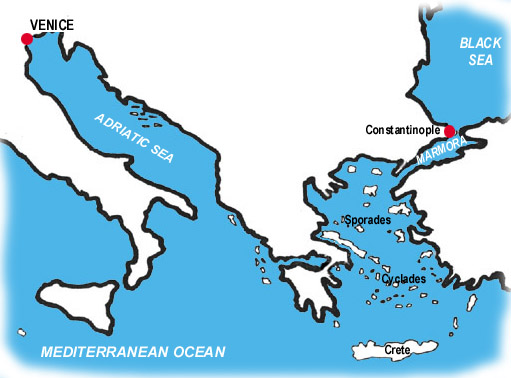Byzantium Dismembered
The rewards
that Alexius IV had promised to the forces of the Fourth Crusade for
assaulting Constantinople in July 1203
and placing him on the throne of the Byzantine Empire in his uncle's
stead proved chimerical. Alexius's efforts to raise the funds through
new taxes eroded his own support in the city. His promise to place
the Byzantine Church under the authority of the Pope at Rome provoked
still more anger and opposition. At the same time the Crusader forces,
encamped across the Golden Horn at Galata, proved to be disruptive
guests on their occasional forays into the city. With the onset of
winter, events unravelled the expectations of all of the parties--with
the possible exception of Doge Enrico Dandolo,
who had longer vision and greater ambitions for Venice. The drama's
final act began in January 1204. The Byzantine nobleman Alexius Ducas
treacherously organized the assassination of the Angelus family's
co-Emperors Isaac II and Alexius IV, arranged his own coronation as
Alexius V, and moved swiftly to strengthen the city's fortifications
against the renewed Crusader attack that was certain to follow by
Spring. For the Crusaders, however, the first order of business was
to decide how to divide the spoils that they confidently anticipated
from their conquering and pillaging of the great capital city. Since
they also intended to appropriate the throne of the Byzantine Empire
for one of their own number, a secondary issue was to settle upon
a method for selecting the new ruler.
The selection
of the new ruler was placed in the hands of a 12-man electoral committee.
Six of the members were to be appointed by Doge Dandolo and the Venetians,
the balance by the other Crusaders. The new Emperor, whoever he might
be (and he was expected to be one of the French noblemen among the
Crusaders), would receive one-fourth of Constantinople and the Byzantine
Empire; the rest of the city and empire would be allocated one-half
to Venice and one-half to the other Crusaders. With the serious
business thus resolved, the war could begin. The assault, begun in
April, was more difficult than the one of the prior year, but the
Crusaders prevailed. Horrific looting of the world's richest city
continued for days. Among the art treasures seized by the Venetians
were the four graceful horses that now stand above the portal of the
Basilica of St. Mark at Venice and the vast quantity of jewels and
semi-precious stones that adorn the Basilica's pala d'oro.
In geopolitical terms, however, Venice's greatest rewards were possession
of the eastern shore of the Adriatic, the Cyclade and Sporade islands,
and the shores of Thessaly, the Sea of Marmara and Black Sea, cementing
its control of the trade routes from Europe to both Constantinople
and Asia Minor. To these Venice quickly added--by treaty and by force
of arms--the island of Crete, commanding the approach to the Adriatic
Sea.

Comments?
©
1998-2000 C. I. Gable